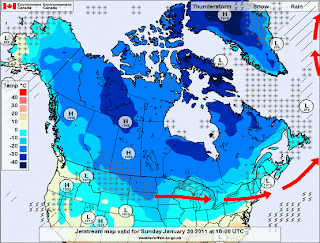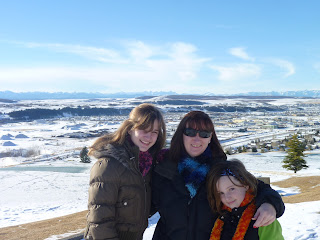So three times this winter, I have heard the term "Alberta Clipper" and I now offer you my quite inexpert understanding of this expression:
IT'S A STORM! Let's add some snow in there. And some wind. And drop the temperature too while we're at it.
(Taken from the Environment Canada website)
The Alberta Clipper is not really something that happens in Alberta - rather it originates from Alberta and causes havoc over much of the rest of Canada, especially the middle prairie provinces. Should I offer an unreserved apology right now on behalf of all Albertans?
You've heard me mention the Chinooks before - warm winds that spread across southern Alberta and raise our temperatures considerably. In very simplistic terms, the Clipper appears to be the side effects for everyone else. And it ain't pretty!
So this week here in Alberta, we have had some sunshine and warmth (up to 13 degrees) and the spring fairies tease us that this winter lark is nearly over. Not bloody likely! We've awoken to about 8cm of new snow this morning - but I think we might get off lightly.
Here's the science part:
An Alberta Clipper is a fast moving weather front of low pressure, usually occurring from December through to February. It takes it's name from
a) the fact that it appears to originate in Alberta, and
b) the fast moving clipper ships from years gone by.
The air picks up moisture from the Pacific Ocean to our West, and then the resulting warm, moist air travels across British Columbia to the Rockies. When it hits the mountains, the air has to travel upwards (sometimes dumping snow on the BC side) - then it comes down the lee side of the mountains into Alberta - bringing us our warming Chinooks. As the air continues to travel at some pace eastwards towards the prairies, it mixes with all the regular winter cold air hovering over Saskatchewan and Manitoba.
The entangled air becomes a storm and gets caught up in the jet stream, and produces windy, blizzard, white-out conditions in it's wake, with accompanying frigid temperatures with dangerous windchill - though, surprisingly, little actual snow because there is little moisture left in the storm air. These storms work their way through the eastern provinces of Canada, and also affect some of the US states to our south east - Montana and the Dakotas especially. When the Alberta Clippers hit the Great Lakes, this usually results in great dumps of lake-effect snow. Sorry!
I'll stop there but you get the general idea. So when the Weather Channel presenter mentions the Alberta Clipper, everyone who lives to my east should prepare themselves for a brutal couple of days.
I suggest a couple of books, chocolate, tinned goods, cuddly scarves, screen-wash and wine. Not necessarily in that order.























